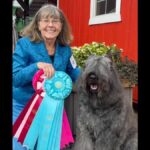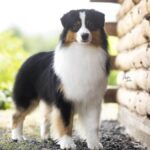Interview with Leslie Puppo Rogers, Breeder of Avalon Pointers & Curly-Coated Retrievers
- Please tell us a little bit about yourself. Where do you live? How many years in dogs? How many years as a breeder? What is your kennel name?
- What is your “process” for selecting show puppies? Performance puppies?
- In your opinion, is your breed in good condition overall? Any trends that warrant concern?
- As a Preservation Breeder, can you share your thoughts on the sport today? How’s the judging these days? What do you think about the number of shows?
- In your opinion, is social media good for the sport? Is it harmful?
- What are the biggest challenges facing the dog show community as a whole today and how can these be addressed?
- What are some of the positive changes you’ve seen in the sport over the past decade?
1. I’m originally from California but have lived in North Carolina for the past 10 years. I have been licensed in California as an Animal Health Technician since 1978. I am a Certified Residential Real Estate Appraiser licensed in California, Washington, and North Carolina. I started showing dogs in 1978 with (American) Cocker Spaniels, got my first Curly-Coated Retriever in 1987, and my first Pointer in 1993. I bred my first Cocker litter in 1985, Curly litter in 1992, and Pointer litter in 1999. Over the years, I have bred Petits Bassets Griffons Venéens, German Wirehaired Pointers, Flat-Coated Retrievers, and Japanese Chin. My kennel name was Avanti. When Richard and I got married, I started using his kennel name, Avalon.
2. Structurally, I grade my litters at eight weeks. I evaluate temperament and movement from the time they are born. I don’t have a defined process, it’s based on experience and gut feeling. I spend a lot of time just sitting and watching the puppies play and interact with their littermates.
3. I feel Pointers are in good shape, there are numerous breeders who are experienced and successful. I am concerned about the future for Curlies. Many experienced breeders are nearing the end of their breeding programs with no one interested in learning and carrying on. We have new breeders who have no idea how to linebreed or research pedigrees. They are using frozen semen from foreign dogs that they know nothing about other than pictures they have seen.
4. There are too many shows and no fun matches. Too many shows means the numbers are low, and in many breeds it takes only four for a major. If you have a dog that is fairly sound, will stand for exam, and will go around the ring wagging its tail, you can finish it. I don’t think most judges ever see enough of either breed (Pointers and Curlies) to know what is correct. Typey dogs get beat by generic dogs all the time. New people in the breed don’t even know correct breed type.
5. Social media is bad for the sport on so many levels.
6. Growing up, purebred dog breeders were admired. Having a well-bred purebred dog was something to be proud of. Now, breeders are vilified and “designer dogs” are status symbols. It is harder for breeders to keep a lot of dogs, so most people are unable to have a robust breeding program unless they can partner with other breeders. I would like to see AKC help to promote preservation breeders more.
7. I can’t think of any positive changes in the past 10 years









